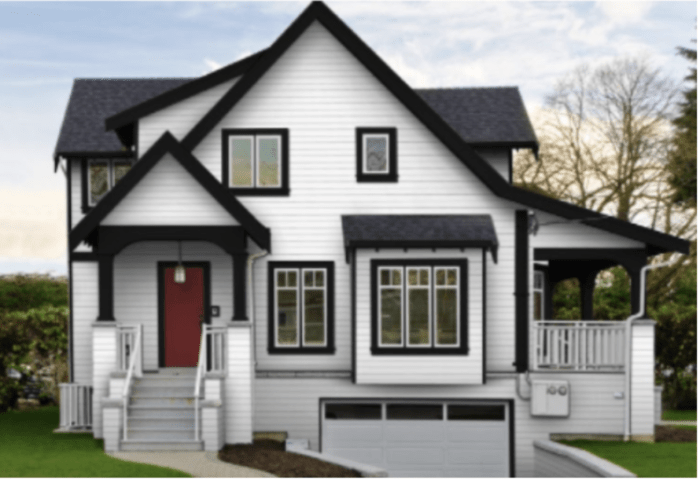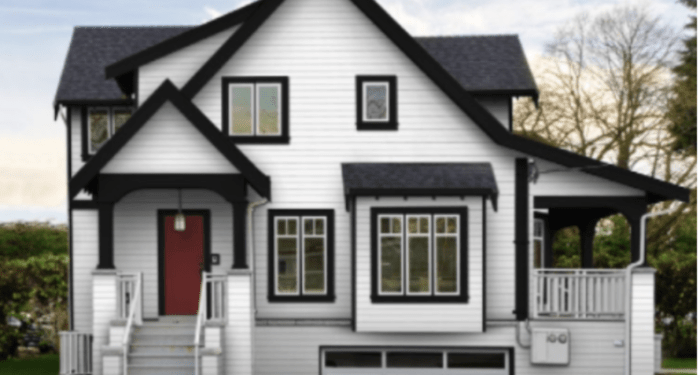Introducing the elegance and versatility of white exterior siding, this guide delves into the various types, pros and cons, as well as tips for choosing and maintaining this classic choice for homes.
From the durability of different materials to the impact on curb appeal, white siding offers a timeless aesthetic that can transform any home.
Types of White Exterior Siding
When it comes to white exterior siding, there are several types of materials to choose from, each with its own unique characteristics and benefits. Let's explore the most common options:
Vinyl Siding
Vinyl siding is a popular choice for homeowners due to its affordability and low maintenance requirements. It is durable, weather-resistant, and comes in a wide range of styles and textures. However, it may not offer the same level of insulation as other materials and can fade over time.
Wood Siding
Wood siding gives a classic, natural look to a home and can be painted white for a clean and timeless appearance. While wood siding is durable and offers good insulation, it requires regular maintenance to prevent rot, warping, and insect damage.
It is also more susceptible to moisture compared to other materials.
Fiber Cement Siding
Fiber cement siding is a versatile option that combines the durability of cement with the appearance of wood. It is resistant to fire, insects, and rot, making it a low-maintenance choice for white exterior siding. Fiber cement siding can be painted to achieve the desired white color and is known for its longevity and strength.
Pros and Cons of White Exterior Siding

White exterior siding can offer numerous benefits to a home, but there are also potential drawbacks to consider.
Advantages of White Exterior Siding
- Timeless and Classic Look: White siding provides a clean and timeless appearance that can enhance the curb appeal of any home.
- Reflects Heat: White color reflects sunlight and heat, helping to keep the interior of the home cooler during hot weather.
- Versatile and Complementary: White siding can easily complement various architectural styles and colors of trim or accents.
- Perceived Larger Space: White siding can create an illusion of a larger space, making the home appear more spacious and inviting.
Disadvantages of White Exterior Siding
- Shows Dirt and Stains: White siding is more prone to showing dirt, stains, and discoloration, requiring more frequent cleaning and maintenance.
- Prone to Fading: White color can fade over time due to exposure to sunlight and harsh weather conditions, requiring repainting or touch-ups.
- May Look Stark: In some cases, white siding can appear too stark or bright, especially in certain lighting conditions, potentially detracting from the overall aesthetic of the home.
- Less Privacy: White siding may not offer as much privacy as darker colors, as it can be more transparent and allow light to pass through.
Choosing the Right White Exterior Siding

When it comes to choosing the right white exterior siding for your house, there are several factors to consider. From the shade of white to how it coordinates with other exterior elements, making the right choice can greatly impact the overall look of your home.
Shades of White
- Brilliant White: This shade of white is bright and clean, giving a modern and fresh look to your home.
- Off-White: A softer alternative to brilliant white, off-white can create a more subtle and classic appearance.
- Creamy White: This warmer shade of white can add a cozy and inviting feel to your home.
Coordinating with Other Elements
- Trim: Choosing a white siding that complements the trim color can create a cohesive and polished look.
- Doors: Consider how the white siding will look next to the color of your doors. A contrasting color can make a bold statement.
- Landscaping: White siding can work well with various landscaping elements. Consider how it will look against greenery, flowers, or hardscaping.
Installation and Maintenance Tips
When it comes to installing and maintaining white exterior siding, there are a few key steps to keep in mind to ensure the longevity and appearance of your home's exterior.
Installation Process
- Start by preparing the surface where the siding will be installed, ensuring it is clean and free of any debris or damage.
- Measure and cut the siding panels to fit the dimensions of your home, making sure to leave room for expansion and contraction.
- Secure the panels to the exterior of your home using the appropriate fasteners and following the manufacturer's guidelines.
- Finish the installation by sealing any gaps or joints to prevent moisture from seeping behind the siding.
Maintenance Tips
Maintaining white exterior siding is essential to keep it looking fresh and clean for years to come. Here are some tips to help you maintain your white siding:
- Regularly clean your siding with a mixture of water and mild detergent to remove dirt, grime, and mold.
- Inspect the siding for any signs of damage, such as cracks or warping, and repair them promptly to prevent further issues.
- Consider applying a fresh coat of paint or sealant every few years to protect the siding from fading and weather damage.
Common Issues and Solutions
- Discoloration:Over time, white siding may become discolored due to exposure to the elements. To address this issue, consider using a specialized cleaning solution or hiring a professional pressure washing service.
- Mold and Mildew:White siding is prone to mold and mildew growth, especially in damp or shaded areas. Regularly cleaning the siding and ensuring proper ventilation can help prevent this issue.
- Peeling Paint:If the paint on your white siding begins to peel, it can expose the underlying material to moisture and damage. To fix this, remove the peeling paint, sand the surface, and apply a fresh coat of paint to protect the siding.
End of Discussion
In conclusion, white exterior siding remains a popular choice for homeowners seeking a clean, fresh look that elevates their property's appearance. With proper selection and maintenance, white siding can truly enhance the overall charm of any house.
FAQ Compilation
What are the main types of white exterior siding available?
Common types include vinyl, wood, and fiber cement, each with its own unique characteristics.
How do I choose the right shade of white for my home's exterior?
Consider factors like natural light, surrounding colors, and personal preference to find the perfect white tone.
What maintenance tips can help prolong the life of white siding?
Regular cleaning, inspections for damage, and prompt repairs are essential to maintain the pristine look of white exterior siding.















